In the world of fashion, some garments transcend time, effortlessly blending cultures and trends to create an ensemble that is both elegant and comfortable. Among these timeless pieces stands the Kaftan dress—a symbol of grace, versatility, and cultural heritage. Originating from ancient Mesopotamia, the Kaftan has evolved over centuries, adapting to different regions and fashion movements while retaining its distinctive silhouette and allure. In this comprehensive exploration, we delve into the essence of the Kaftan dress, uncovering its rich history, contemporary interpretations, and enduring appeal.
1. Origins and Historical Significance:
The origins of the Kaftan dress can be traced back to ancient Mesopotamia, where it was initially worn by royalty and nobility as a symbol of prestige and luxury. Over time, the Kaftan spread across various civilizations, including the Ottoman Empire, Persia, and the Indian subcontinent, each culture infusing its unique style and craftsmanship into the garment. Renowned for its loose-fitting silhouette, flowing fabric, and intricate embellishments, the Kaftan became synonymous with opulence and refinement, adorning monarchs and aristocrats during ceremonial occasions and celebrations.
2. Cultural Influences and Global Adaptations:
As trade routes expanded and cultures intermingled, the Kaftan underwent a series of transformations, incorporating elements from diverse traditions and regions. In North Africa, the Djellaba emerged as a variation of the Kaftan, characterized by its hooded design and vibrant geometric patterns. In the Middle East, the Thobe became a staple garment for men, featuring elaborate embroidery and embellishments. Meanwhile, in South Asia, the Anarkali—a fusion of the Kaftan and traditional Indian attire—captivated audiences with its voluminous skirt and ornate detailing. These global adaptations attest to the Kaftan's universal appeal and its ability to transcend cultural boundaries.
3. Modern Interpretations and Contemporary Fashion:
In the contemporary fashion landscape, the Kaftan continues to captivate designers and fashion enthusiasts alike, undergoing reinterpretations that reflect current trends and sensibilities. From high-end runways to bohemian boutiques, the Kaftan has found its place in both casual and formal settings, offering versatility and comfort without compromising on style. Designers experiment with various fabrics, prints, and silhouettes, reinventing the classic Kaftan to suit modern tastes while honoring its timeless essence. Whether it's a minimalist linen Kaftan for a beach getaway or a sequined masterpiece for a glamorous soirée, the Kaftan embodies effortless chicness for every occasion.
4. The Versatility of the Kaftan Dress:
One of the defining features of the Kaftan dress is its versatility, transcending age, body type, and cultural background. With its loose, flowy silhouette, the Kaftan provides comfort and ease of movement, making it an ideal choice for women of all shapes and sizes. From petite to plus-size, the Kaftan accentuates the body's natural curves while offering coverage and modesty. Moreover, its adaptability allows for various styling options, whether cinched at the waist with a statement belt or layered over trousers for a contemporary twist. From casual daywear to formal evening attire, the Kaftan seamlessly transitions from one occasion to the next, embodying effortless elegance and timeless sophistication.
5. Embracing Sustainability and Ethical Fashion:
In an era of heightened environmental awareness and ethical consumption, the Kaftan dress aligns with the principles of sustainability and slow fashion. Crafted from natural fibers such as cotton, silk, and linen, Kaftans are breathable, biodegradable, and environmentally friendly. Artisans employ traditional techniques such as hand weaving, block printing, and embroidery, preserving age-old craftsmanship and supporting local communities. Moreover, the timeless appeal of the Kaftan promotes longevity and versatility, encouraging consumers to invest in quality garments that withstand the test of time, rather than succumbing to fleeting trends.
Conclusion:
In conclusion, the Kaftan dress stands as a testament to the enduring allure of timeless fashion. From its ancient origins to its contemporary interpretations, the Kaftan embodies elegance, versatility, and cultural richness. As a symbol of heritage and modernity, the Kaftan transcends boundaries, embracing diversity and celebrating the beauty of individual expression. Whether worn as a cultural statement or a fashion statement, the Kaftan remains a cherished garment that continues to inspire and enchant generations to come. Visit the official website newarabia.co.uk

